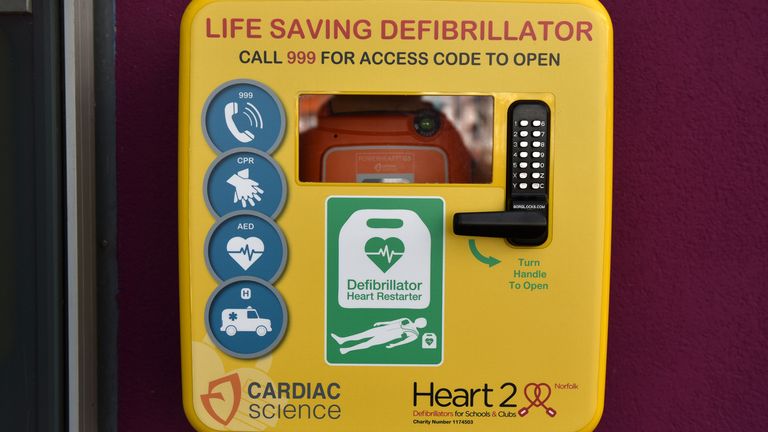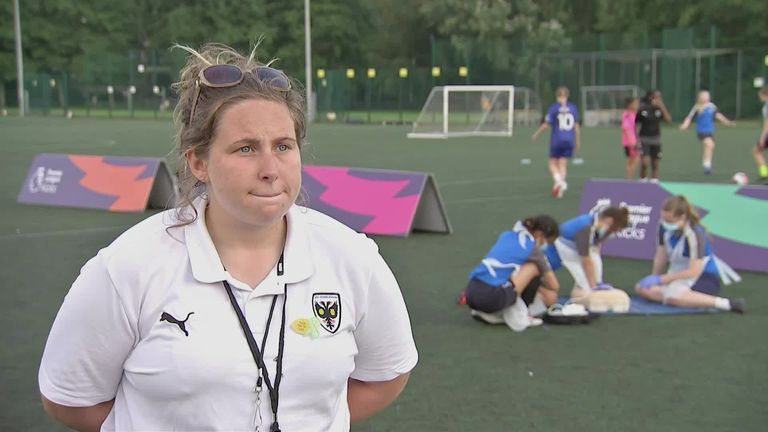

A Premier League doctor has urged “everybody possible” to learn to use a defibrillator as the first of more than 2,000 devices being provided to grassroots facilities was installed on Monday.
The Premier League announced in June that it would fund the provision of 2,000 Automated External Defibrillators (AED) at grassroots football clubs and facilities, in the hope of saving the lives of people experiencing sudden cardiac arrest.
Awareness of the danger of sudden cardiac arrest was raised after Denmark midfielder Christian Eriksen collapsed during a Euro 2020 match in June, with life-saving cardiopulmonary resuscitation (CPR) performed on the pitch with the use of a defibrillator.
Crystal Palace head of medicine Dr. Zaf Iqbal was representing the Premier League as the first device was installed at a community venue of League One side AFC Wimbledon.
“This initiative is really welcome because if you look at the stats every week, between 12-16 young people under the age of 35 die as the result of a sudden cardiac arrest,” Iqbal told Sky Sports News.
“The majority in those cases is because there isn’t a defib nearby.
“We know that every minute’s delay of getting a defib onto the patient results in a 10 per cent decrease in survival.
“The more defibs that are around and readily available, the more people that are trained in CPR and basic life support, the better chance we have that when people do have a cardiac arrest, giving them the best chance of survival.
“I think it really is vital that everybody possible, certainly every school leaver, every adult should know how to CPR, should try and find out where the nearest defib is, because if you look at the stats they may come across somebody with a cardiac arrest.”
Eriksen’s survival led to renewed calls for more defibrillators to be installed at grassroots venues.
However, the former Tottenham midfielder’s collapse did not represent the first time English football fans had been exposed to such a situation, with Fabrice Muamba having been forced to retire after he suffered a cardiac arrest on the pitch for Bolton in 2012.
“Everyone could see the importance of defibrillators just last month following the unfortunate circumstances where Christian Eriksen had a collapse,” Iqbal said.
“There’s no doubt the fact that they were able to get a defib on him as soon as possible is what resulted in a successful outcome.
“It’s sad in some ways that it takes something like a Christian Eriksen or a Fabrice Muamba incident for people to realise the importance of defibs, but that’s the way of the world and I think it’s only a positive thing that the Premier League has taken it on board and is doing something about it.”
At the launch of the defibrillator installation on Monday, the FA also provided training for local youngsters in CPR.
AFC Wimbledon community coach Maddie Sweetman agreed with Iqbal that such training is crucial to ensuring that full use is made of the defibrillators.
“I think it’s absolutely vital that we get them everywhere we can really,” Sweetman said.
“It is something that is intense and that’s why I think from a young age you should learn how to use them because it’s something that if you’re not sure how to use can be very scary to face.
“So initiatives like this where we’re getting the girls to have a go and learn how to use the defibs will really, really help them.”
What is CPR?
CPR stands for cardiopulmonary resuscitation and is a medical technique that is given to someone who goes into cardiac arrest.
That occurs when the heart encounters an electrical issue and stops pumping blood around the body and to the brain, causing the person to fall out of consciousness and stop breathing.
Medics define this as ‘clinical death’, which is the onset of biological death, although CPR can help re-start the person’s heart functions and save their life.
By administering chest compressions and rescue breaths, the CPR performer helps to pump blood and oxygen around the person’s body, taking over the role of their heart and lungs.
How do you perform CPR?
Always seek professional help by calling 999 before starting CPR.
The NHS’s advice to carry out chest compressions is as follows:
- Place the heel of your hand on the breastbone at the centre of the person’s chest. Place your other hand on top of your first hand and interlock your fingers.
- Position yourself with your shoulders above your hands.
- Using your body weight (not just your arms), press straight down by 5 to 6cm (2 to 2.5 inches) on their chest.
- Keeping your hands on their chest, release the compression and allow the chest to return to its original position.
- Repeat these compressions at a rate of 100 to 120 times a minute until an ambulance arrives or you become exhausted.
The British Heart Foundation recommends that in an emergency situation it is better to try and perform CPR, even if unsure, rather than to not do anything at all.
For more information on FA medical courses which can help to deal with such things as cardiac arrest and how to treat them, visit the FA Bootroom.
read the full story about ‘Everybody should learn to use defibrillators’
#theheadlines #breakingnews #headlinenews #newstoday #latestnews #aajtak #ndtv #timesofindia #indiannews



Leave a Reply